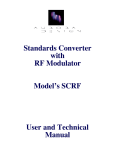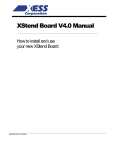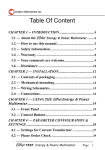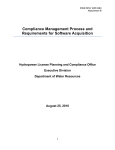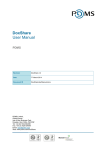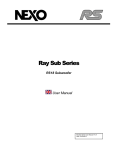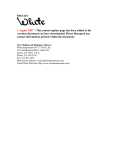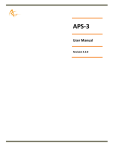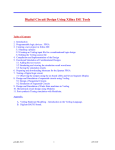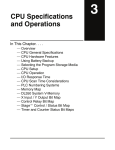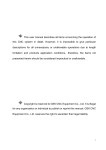Download SC_downloads_files/Single RF User Manual 1.8
Transcript
Standards Converter with RF Modulator User and Technical Manual Copyright 2006 DAH Revision 1.8 4 January, 2007 Introduction Introduction This manual covers the operation and technical aspects of the Single-Standard Converter with RF Modulator. The Converter is designed to accept an NTSC or PAL/SECAM video signal and convert to one of several different output standards depending on the model. The converted video is sent to the built-in RF Modulator, along with the audio, and to a composite video output connector. Features • Compact, low power, surface mount design • Front panel Status LED • Internal user switch selectable options control • Flexible built-in RF Modulator: - Up to 30 selectable carrier frequencies - Programmable between 30-880MHz (actual channels vary by model) - Supports positive/negative video and AM/FM audio modulation schemes • Converter bypass mode for use as stand alone RF Modulator • Extremely stable output: +/- 3% levels, +/- 50ppm timing • Output clock line locked to input clock for perfect conversions • 10 bit video D/A for greater than 54dB dynamic range • 4Mb FLASH Image Memory for storing a custom image • 100K gate equivalent FieldProgrammableGateArray • EEPROM memory for FPGA firmware, field upgradeable • Extremely accurate algorithms used for conversions: - Three line interpolation on all standards - All internal calculations done to a minimum 12 bit precision • Unique partial-field memory for stable output syncs • Externally adjustable audio modulation depth control • Automatic Sleep Mode for low power standby operation • Versatile I/O: - Composite Video Input (NTSC/PAL, 1Vpp, 75 ohm) - Composite Video Output (various standards depending on model, 1Vpp, 75 ohm) - Stereo Audio Inputs (0.2Vpp-5Vpp, 10k ohm) - RF Output (76dBμV, 75 ohm, approx. 6mV) - DC power (7-14Vdc, 250ma) 3 Introduction Front Panel The front panel connections are shown below: Composite Video Input Left Audio Input Status LED Right Audio Input Audio Level Composite Video Input: The Composite video input signal required depends on the operating mode. If the converter is enabled (not bypassed), then a video source conforming to the NTSC or PAL/SECAM video standards must be supplied to the Composite (RCA or BNC) input connector. The converter will use this video signal to convert to the model’s output standard. Connecting a video signal not conforming to the NTSC or PAL video standards will result in erratic operation in this mode. If the converter is set to bypassed, then the video signal on this connector is sent to the modulator with no signal processing, other than an audio trap filter. Any video signal can be supplied in this mode, although it is the users responsibility to verify this video signal to obtain the desired result from the modulator. Audio Inputs: Two RCA connectors are provided for audio input. The two connectors are summed internally into a mono signal that is fed to the RF modulator. If only a mono source is available, it can be connected to either of the audio input connectors, or both through a “Y” cable if higher input gain is required. Due to the variance of audio output levels from most devices, an audio input gain control is provided which allows the user to set the modulation depth of the audio RF carrier to suite the source level. Please refer to Specifications sections found later in this manual. 4 Introduction Status LED: The status LED conveys the current operating state of the converter. Slow Flashing: No video input signal detected. Default image will be output. Solid: Converter locked to video input. Normal operation. Pulsating: Converter in low power Sleep mode. Fast Flashing: Converter storing default image to internal FLASH Audio Level: The Audio Level control is used to set the modulation depth of the audio RF carrier. This control is required to handle the variations in the audio output levels from different devices. This control should be set to the maximum possible without causing distortion of the audio in the RF signal. The potentiometer is adjusted by inserting a small flat blade screw driver into the hole, and turning it until it engages the rotor of the potentiometer. Maximum drive is obtained by turning the potentiometer clockwise. Rear Panel The rear panel connections are shown below: Composite Video Output RF Output 9Vdc Input User Pushbutton 5 Introduction Composite Video Output: This RCA or BNC connector provides the video output from the converter. This output should terminate into a 75 ohm load. This output is only valid when the converter is not set to bypass mode. If the converter is set to bypass mode, no signal will be present at this output. For complete information about the characteristics of this output, please refer to the Specifications section found later in this manual. RF Output: This F connector provides the RF output from the modulator. This output should terminate into a 75 ohm load. It should only be used to connect directly to the antenna terminals of a television set, and never be used for broadcast purposes. For complete information about the characteristics of this output, please refer to the Specifications section found later in this manual. Power: The converter requires a power source of between 7.0 and 12 volts DC at 250 mA. A 9 volt DC power supply is recommended to reduce power consumption. Voltages over 16 volts will damage the unit. The unit has a reverse polarity diode in series with the input, so it will not be damaged by reversal of polarity. The unit uses a standard 2.1mm X 5.5mm, center positive, coaxial power connector as found on most consumer electronic equipment. User Pushbutton: The User Pushbutton is used to store a default image into the internal FLASH memory. On the SCRF525MSC, it is additionally used to control the color phasing of the output, rotating by one field each time the button is pushed momentarily. To store a default image, the converter must be in it’s normal operating mode, with a valid video input connected, and a Solid Status LED. If a valid video input is not connected, the button will have no effect. With a stable, stationary video input applied, the user button may be pressed and held by inserting a paper clip, or other small tool into the hole in the back of the unit. The Status LED will begin to flash quickly, indicating storing of the image FLASH is taking place. This process can take up to 30 seconds, and the video signal must not be disturbed during this process. Once the image is stored, the Status LED will return to solid. Once an image is stored, whenever there is no video input connected to the unit, the default image stored in the FLASH will be outputted. Caution! Because of the nature of the partial-field memory contained in this unit, 6 Introduction the default image is stored in bands of several lines at a time. If the connected video is not stationary during the storing process, the resulting image will be distorted. The best way to provide a stationary image for storing is to use the output from a computer video card, or a DVD/PVR player in pause. A typical VCR without a TBC in pause is not suitable for this use. If the VCR does have a TBC, then it can be set to pause and used to supply the unit with a video image during the storing process. Internal Options The internal Options switch and AM Audio RF Carrier control are shown below: Sound Trap Adjust Test Point R40 1 2 3 4 5 6 7 8 S2 R1 U1 R4 Back of unit (Outputs) Option Switch R8 C30 U2 R2 R49 U8 C30 AM Audio Carrier Adjust ON R11 R7 R6 R34 L3 C55 L2 Sound Trap Adjust J5 R4 R8 R55 7 J6 Front of unit (Inputs / LED) Introduction The internal Option Switch (S2) has eight controls allowing the user to set the operating mode of the converter. In order to change the switch settings, the cover must be removed from the unit. To do this, first remove all cables from the unit, including the power cable. Place the unit on it’s top, and remove the two, small phillips screws from the bottom. Flip the unit back over, and remove the top. Caution! In the subsequent steps, make sure you are touching one of the outer metal rings on the phono or RF connectors to discharge any static electricity that may be present before proceeding. There are static sensitive devices inside the converter that can be damage if subjected to a static discharge. Failure to follow this procedure will result in damage to the unit! Using a small tool such as a paper clip, carefully slide the desired switch to it’s new position being careful to not put an undue amount of force on the switch that might damage it or the circuit board. Once the desired switch settings have been achieved, replace the cover on the unit, and reinstall the two phillips screws. Position 1,2,3,4 - RF Channel Select: These switches are used to select the Channel for the RF System the particular model supports. (currently System A,E,F,L and M) When all four switches are off, the RF modulator is disabled and put into a low power state. In this mode, the unit will still output a converted video signal on the composite output connector. When the switches are set to a valid setting as shown in the Appendix, the given RF Channel will be output on the RF connector. Position 5 - RF System Select: This switch is used to select between two different RF Systems. It is currently implemented on the SCRF441NM, SCRF343M, SCRF819F and SCRF819L models. This switch should be OFF for 1946 System M channel assignments, and ON for 1940 System M channel assignments on the SCRF441NM model. This switch should be OFF for 1937 System M channel assignments, and ON for 1934 System M channel assignments on the SCRF343M model. This switch should be OFF for System F or L channel assignments, and ON for System E channel assignments on the SCRF819F and SCRF819L models respectively. (Note: the System E channels on these models will operate at a reduced video bandwidth) Position 6 - Equalization Pulses: This switch is used to enable/disable equalization pulses in the vertical (frame) sync for the 819/25i, 455/25i, 405/25i and 343/30i models. This switch has no effect on the 441/30i model as this standard originally included equalization pulses. 8 Introduction When these formats were first created, they did not include equalization pulses in the vertical (frame) sync. Because of this, poor interlacing of the image can result due to difficulty of the vertical (frame) oscillator in the television properly locking to the signal. Equalization pulses are added before and after the serration (broad) pulses to improve the vertical (frame) oscillator's ability to lock to the sync signal. All modern analog video formats utilize equalization pulses in the sync. When this switch is ON, equalization pulses will be added to the listed formats for better synchronization. While this does create a better interlaced image, it is not historically accurate, and does not represent the formats as they would have originally appeared. This should be the default position of this switch in most cases. When this switch is OFF, the equalization pulses will not be added, resulting in the formats as they would have been. This may result in a poorly interlaced image on the television, exactly as it would have been when originally broadcast. This mode can be used to better convey what these formats would have looked like originally. For the 819/25i standard, when this switch is ON it selects the Belgian 819/25i standard which contained equalization pulses, and when OFF selects the French 819/25i standard which did not. Position 7 - Sleep Disable: This switch is used to disable the Sleep Mode. When this switch is OFF the Sleep Mode will operate normally as discussed in the next section. When this switch is ON, the Sleep Mode will be disabled, and the unit will not go to sleep. This can be usefull when using the unit as a test pattern generator while working on a television and no video input signal is connected. Position 8 - Converter Bypass: This switch is used to bypass the internal Standards Converter, and use the unit as stand alone RF Modulator. In the OFF position, the converter and modulator operate normally. In the ON position, the converter is bypassed, and the video signal on the composite input connector is sent directly to the modulator. R49 - AM Audio RF Carrier Control: This trimmer is used to set the initial level of the audio carrier for RF Systems that use AM audio. For RF Systems that use FM audio, this level is set automatically, and this trimmer has no effect. This control is set at the factory and should never need adjustment. C55 - Sound Trap Adjust: This trimmer is used to set the Sound Trap Filter to keep video frequencies out of the audio carrier. This control is set at the factory and should never need adjustment. 9 Introduction Operating Modes Normal Full Operating Mode: When a valid video input is present and an RF Channel is selected, the Status LED will show a Solid light, and the unit will output converted video on the composite output connector and on the RF connector. This is the mode that will most often be used. Converter Only Mode: This mode is similar to the Normal Full Operating Mode except the RF Channel selection switches are all set to OFF disabling the RF modulator. In this mode the converted video output will only be present on the composite video output connector. This mode is useful when connecting to a video monitor that has a composite video input. RF Modulator Only Mode: In this mode the standards converter is bypassed and placed into a low power mode. The video on the composite input connector is only processed by an audio trap filter before being sent to the modulator along with the audio that is present on the audio input connectors. This mode is useful when only an RF Modulator is required as with the use of custom or nonstandard video signals, or for experimentation. Since the video is sent unprocessed to the modulator, it is the responsibility of the user to verify the suitability of this signal. Also, since the video input is not required to meet any particular specification in this mode, and since the presence of valid NTSC or PAL/SECAM video is used to detect the Sleep feature, the Sleep feature is not available in this operating mode, and the unit will not go into Sleep. Default Mode: When the unit is in the Normal or Converter Only modes, and no valid video is connected to the composite input, the unit will output the image stored in the image FLASH on it’s outputs. This can be used to verify operation of the unit, or aid in setup of the television. The unit is shipped with an appropriate test pattern stored in the image FLASH, but this can be over written at any time as previously explained. Sleep Mode: Since no power switch is supplied on this unit, an automatic Sleep Mode will be entered whenever the video input is not present for more than 1 hour. This feature is available when operating in the Normal or Converter Only modes. It is not available 10 Introduction in the RF Modulator Only mode. With this feature, the RF Modulator is shut down, along with the standards converter, image FLASH, and the video output. Only the video decoder is left active to signal when a valid video input is again supplied to the unit to wake it up. This Mode can be disabled using one of the internal option switches, This is usefull when the unit is used as a test pattern generator and no video input is connected. Typical Connections In normal usage, the desired RF Channel is selected on the internal Option switch as previously described. The power adapter is connected to the converter and to the AC power source. A valid NTSC or PAL video source should then be connected to the video input. The video source can be anything from a VCR to a DVD to an off-air broadcast. For the best quality, a DVD or PVR is recommended. The video output can then be connected to the input of a video monitor, or the RF output can be connected to the antenna terminals of a television. A balance transformer may be needed to convert the 75 ohm output of the unit to the appropriate signal type for the television. Caution! The RF output from the internal modulator uses a double side band modulation technique, and is not suitable for broadcast without filtering. Also, due to the method of frequency division provided in the RF modulator IC’s, their outputs are rich in harmonics. It is intended to only be connected directly to a television’s antenna input. At no time should the RF output from this unit be connected to an antenna for the purpose of broadcasting the signal. While no damage will result to the unit, it is against the law in most countries to use a modulator in such a manor. The audio from the source device (VCR, DVD, etc.) should be routed to the converters audio inputs. Two inputs are provided with low cross talk so a stereo audio signal can be fed to the unit. The two channels are combined to form a mono signal. If only a mono audio source is available, it can be fed to either input. For additional audio gain, a “Y” cable can be used with a mono source to feed both inputs. The use of high quality video cables is recommended for best results. Cables conforming to 75 ohm impedance should be used on the video inputs and outputs. Cables of lesser quality can be used for the audio channels. There should now be a solid status light on the front panel indicating a locked video signal as described previously, and a stable image on the television. To help aid in setup, when no video input is presented to the converter, it will output a default image. This can be useful in making final adjustments to the television. The audio level control can be adjusted to set the audio RF modulation depth for 11 Introduction the connected source. This control should be set to the maximum setting without causing distortion of the audio. If the audio is distorted, this control should be lowered slightly. If the audio is low in volume or noisy, this control should be raised. It can be adjusted my inserting a small flat blade screw driver in the hole in the front panel. A clockwise turn will increase the level, while the opposite will decrease the level. An additional benefit of the converter can be found in it’s video processing path. Since most early television sets did not have Vertical Blanking Interval Suppression, or Chroma Traps, retrace lines and moire patterns can be visible when using modern video signals. The converter will suppress the VBI signals eliminating retrace lines, and contains a 4 line adaptive comb filter to remove the chroma signal eliminating moire patterns. Theory of Operation In order to convert between different video standards of the same frame rate, only spatial correction is required. Spatial correction involves changing the resolution, size and aspect ratio of the incoming video to the output video format. This can be easily achieved through standard digital methods utilizing scalers and FIR filters. This will be discussed in detail. It was decided that no off the shelf components existed that would provide the desired functionality, so a FieldProgrammableGateArray, or FPGA, was chosen to provide all the digital functionality. By adding input/output circuitry, memory, and ancillary circuitry to the FPGA, the entire system could be realized. The basic building blocks to the design are; FPGA, video decoder (ADC), video DAC, RF modulators, image FLASH memory, audio amplifier, and multiple power supplies. A brief description of each part follows: FPGA: Xilinx XC3S100E-4VQ100 100K gate equivalent 72Kb block RAM 1.2V Core / 2.5V Aux / 3.3V I/O Video Decoder: TI TVP5150A 9bit ADC’s, 2X Over-Sampled Line Locked Clock 4 Line Adaptive Comb Filter Multiplexed 8bit YCrCb output bus Video DAC: Proprietary Design 10bit effective DAC 35 MSPS maximum conversion rate 56 dB SNR 12 Introduction RF Modulators: Freescale MC44BS373CA (One for video and FM audio, one for AM audio) 30-880MHz Frequency Range Automatic Black Level Clamping 76dBμV Output Level Image Memory: Atmel AT49BV040A-70VI 512K X 8 FLASH ROM Topology A block diagram of the circuitry is shown below: Options Selector/ PushButton Composite Input Video ADC and Decoder Image Memory (FLASH) FPGA PartialField Memory Video PLL Video DAC, Filter and Driver Composite Output Video Switch/ Sound Trap Audio Input Audio Amplifier RF Modulators RF Output The incoming video is digitized and processed by the TVP5150A using a 14.318MHz reference crystal to the ITU-601 (formerly known as CCIR601) specification. All internal timing is generated using this crystal. The video is quantized, processed for brightness, contrast, chroma gain and hue, among others, and output at the ITU rate of 27MHz on an 8 bit, time multiplexed bus, with alternating luma and chroma samples. No other signals are required from this circuit as the ITU specification describes a method for encrypting the horizontal and vertical timing 13 Introduction information directly into the digital data using timing reference makers, or TRS codes. A brief description of the ITU-601/656 specification is as follows: Fundamental quantization frequency: 13.5MHz Pixel Resolution: 720 H x 486 V NTSC / 720 H x 576 PAL Image Aspect Ratio: 4:3 Pixel Aspect Ratio: 1.1 NTSC / 0.9 PAL Horizontal Frequency: 15,734 Hz NTSC / 15,625 Hz PAL Vertical Frequency: 29.97 Hz NTSC / 25 Hz PAL Clocks per Line: 1716 NTSC / 1728 PAL (27MHz clock) Clocks per Frame: 900900 NTSC / 1080000 PAL (27 MHz clock) Notice that the vertical frequency is 29.97Hz for NTSC, not 30Hz as expected. This is due to the NTSC color system that was first ratified in 1953. All monochrome television transmissions prior to this standard used exactly 30Hz, or 30 frames per second, so as to be in sync with the AC line frequency. This is done to reduce distortions in the image due to induced AC fields or “hum” from the power supplies of these early sets. In order to devise a “compatible” color system that would show a monochrome signal on existing sets, RCA proposed a method of modulating the color components of the video signal onto a subcarrier in the video. For reasons beyond the scope of this manual, a frequency needed to be chosen so that no standing patterns in the color signal would result. This required lowering the vertical frequency from 30Hz to 29.97Hz. While this change caused no adverse side effects on televisions, it has created a legacy of problems for modern video equipment. Instead of being able to use integer numbers like 24, 25 and 30, we now have to include 29.97 which makes many calculations and conversion extremely difficult. For digital processing, the ratio 1000/1001 has been established as the conversion between 30 and 29.97 video. The digital video data is then routed to the FPGA where it is further processed. The data is sent to the internal partial-field memory in round robin fashion. The partial-field memory is large enough to hold many lines of video, so there is always enough data to keep an uninterrupted flow to the output. All the above processing is done synchronous to the ITU clock, so no additional clocks are necessary at this point. Before any further processing can be done, a new clock, synchronous to the output standard but integrally related to the ITU clock must be generated. The internal DCM’s are used for this purpose. By carefully choosing the ratio’s, and cascading two DCM’s together, the exact frequency for the output standard can be generated in the FPGA. This clock needs to run at least three times the actual pixel clock desired for reasons that are shown below, but it is actually run at six times to provide for oversampling, and running the proprietary DAC. With this new output synchronous clock, a video timing generator, or flywheel is created in the FPGA to generate all timing signals for the model’s output standard. All horizontal, vertical, pixel count and line count generation is done in this process. Additional, frame timing signals in the form of equalization and serration pulses can be generated. This is the main “heartbeat” process for the entire design. 14 Introduction Using these timing signals, the video data that was stored in the partial-field memory synchronous to the incoming ITU video clock can now be clocked out synchronous to the new output clock. The data only needs to be downscaled vertically before being output to the video DAC. This is done by reading three pixels out of adjacent lines, and interpolating the desired output pixel. Since three pixels need to be read out of the memories for each pixel sent to the DAC, this is why a three times clock is required. With all the above timing now generated, the output video can be created. The signals from the flywheel are routed to the video output DAC at the appropriate times in the signal, while the processed video from the partial-field memory is routed to the video DAC during the active portions of the video signal. The DAC is run at a two times over sampled rate to reduce filtering requirements, and increase SNR. The video is then filtered and buffered before being sent to the composite output connector and to the RF Modulator section. In the RF Modulator, the video is sent through a sound trap filter to remove any video frequencies that would interfere with the audio RF carrier. Also in this section, a video switch is provided ahead of the sound trap filter that allows the video input to the RF Modulator to come from the output of the DAC, or directly from the composite video input connector as used in the bypass mode. Audio from the audio input connectors is combined, filtered and amplified before being sent to the RF Modulator. An externally adjustable potentiometer sets the gain of the audio amplifier, thereby setting the modulation depth of the audio RF carrier. An internal potentiometer sets the initial audio RF carrier level for AM modulation schemes. FM modulation schemes are handled internally to the RF Modulator IC’s. Detailed Analysis Generating an output clock: As shown in the previous section, a clock, synchronous to the output standard, but related to the incoming video clock must be generated. This is done using the DCMs built into the FPGA. First we need to decide what output clock frequency we need. Taking the example of 625 input with 405 output, it will be shown that the active video time per line is essentially the ratio between the two formats. For 625 the active line time is 51.95μs while the 405 active line period is 80.30μs. 405/625 is 0.65 while 51.95/80.30 is 0.65. This means we can use the same number of pixels per line in the 405 format as there are in the 625. If this were not the case, we would need to take into account the difference in pixel counts into the final ratio. The final ratio for this example only needs to account for the difference in the number of lines, therefore the base ratio we need is 405/625 which can be reduced to 81/125. If we multiplied the ITU 27MHz clock by this number, we would get a clock that has two counts per pixel in the output, since there are two clocks per pixel in the ITU clock. As stated earlier, we need a clock that has at least 3 clocks per pixel in order to achieve the minimal three line interpolation necessary for good image quality. Also, we actually 15 Introduction want a clock two times higher than this so the output can be over sampled, easing the filter requirements, and yielding a higher SNR. This means the output clock needs to use the base ratio times 3/2 (to get to the 3 clocks per pixel), and then again by 2. So the final ratio required is 81/125 * 3/2 * 2 or 486/250. Taking this ratio and multiplying by the 27MHz ITU clock, the output clock becomes 52.49MHz. Using this new output clock, all processing of the output pixels can be accomplished while still maintaining a lock to the input clock. If this were not done, and the output clock was unrelated to the input clock, as is the case with using a separate oscillator, the output image will have duplicate, dropped, or torn frames. Spatial Correction: With an output clock now available, the image can be processed. In order to convert between different video standards, the video image must first be spatially converted. Many aspects need to be taken into account such as image aspect ratio, and the number of active lines. The distinction of image aspect ratio is made here to differentiate it from pixel aspect ratio which only has to do with how the analog data is quantized. Since this converter is limited to the type of input and output video handled, no spatial correction needs to take place in the horizontal direction. This means that all 720 input pixels will be included in the output line, but at the output clock rate. Only spatial correction in the vertical direction needs to take place. On first inspection, it would appear that this correction can easily be achieved by simple adding or dropping lines to get the desired result. For example, if you have 576 lines in the input, and need 384 lines in the output, dropping every third line would appear to be adequate. This is known as decimation. Unfortunately, one third of the original information is lost, not being included in the output in any way, and since the input lines were spaced differently than the output lines, aliasing of the image will occur. This is most noticeable as stair stepping or jagged edges around objects. To avoid this situation, all lines in the input need to be used to generate the output. A simple solution for the above case would be to use the first line of the input as the first line in the output, and then average the next two lines of the input to create the second line in the output. This is known as two line interpolation. While it provides a vastly superior image to straight decimation, it has several draw backs. First, the output lines will have different frequency content because one line in the output is the same as a line of the input with all vertical frequencies intact, while the next line in the output is the average of two lines of the input, with the frequencies filtered down. Also, since this is just a simple averaging filter, aliasing can occur, introducing image data that does not actually exist. Then consider the case where the output is not a clear division of the input. In the example there were exactly 2/3 the number of lines in the output as there were in the input. Now take the case of 625 input to 441 output. This requires scaling 576 input lines to 406 output lines or a 406/576 ratio, which can be reduced to 203/288. Not an easy ratio to handle with a simple two line interpolator. 16 Introduction By taking more lines into account, a much more accurate representation of the desired ratio can be achieved. By comparing the desired spatial position of the output line to the input lines, and taking a weighted average of several lines around this point, a high quality filter, or interpolator is realized. Through actual tests, it has been shown that carefully chosen weighting coefficients used with four lines gives the best results. It has also been shown that no perceptible loss of image quality occurs when only three adjacent lines are used. Since this converter processes all pixels within the FPGA itself, it can easily handle three or four line interpolation. Because of the higher clock frequency, and therefore higher power consumption required for four line interpolation, and because of the imperceptible difference in quality, a three line interpolator is implemented in this converter. Outputting Pixels: Once the output pixels are generated, they are up-sampled by a factor of two by creating pixel values in-between the actual ones. These are then sent on to the DAC converter, in this case a proprietary converter that uses a combination of R2R ladder and PWM techniques. This creates an effective higher sampling frequency which allows for lower order filters with less group delay distortion. RF Modulator: Due to limitations in the currently available RF Modulator IC’s, two IC’s are used with their outputs combined before being sent out the RF connector. This arrangement allows for positive and negative video modulation coupled with AM and FM audio modulation. Further, in the case of AM audio, any carrier separation between the audio and video can be achieved. The FM audio carrier is limited to +/4.5, 5.5, 6.0 and 6.5MHz from the video carrier. The reference clock for both modulators is derived from a process in the FPGA. This way no external crystals are required, and both modulators are locked to the same frequency. This reference clock is used by the modulators for an internal PLL with an external loop filter. High quality film capacitors are used in the loop filter to minimize microphonics as is the case with any ceramic capacitor. The FPGA programs the modulators as to frequency, modulation type, etc. The video modulator receives it’s input from a switch that allows the FPGA to route video from the converter output, or from the video input connector. The video signal goes through a sound trap filter to eliminate any frequencies that could interfere with the audio carrier. The video modulator contains a DC restorer circuit that sets the correct carrier levels. Audio from the two audio connectors is combined and amplified by an op-amp before being sent to both modulators. For FM audio, the same modulator that is used for the video is enabled, and the carrier spacing set. Initial carrier level is set by the FPGA and depth is set by a gain control provided in the op-amp circuitry. For AM audio, the audio section in the video modulator IC is shut down, and the audio is fed to the video input of the second modulator IC. Feeding the output of the op-amp 17 Introduction directly into the video input of the second modulator overrides the internal DC restorer. This allows full control over the AM audio, including initial level and depth. To set the initial carrier level, a DC offset control is provided in the op-amp circuitry that allows the setting of the input bias. Modulation depth is set by the same gain control. The outputs of the two modulators are then combined through a balanced network that maintains a 75 ohm impedance and sent to the RF connector. Hardware Setup and Test Mode There is a hidden mode of operation that is used during initial setup and test of the converter that may be useful to those users with a technical understanding of the operation of a standards converter. No harm can be done to the unit by simply entering this mode, but care should be taken if the following alignment procedure is attempted. To enter the Setup and Test Mode, remove the power cable from the unit, While depressing the user pushbutton on the rear panel, reconnect the power supply to the unit. The user push button must remain depressed until the front panel Status LED starts blinking. At this point the pushbutton may be released. The Status LED will repeat a pattern of two fast flashes to indicate the unit is in the Setup and Test Mode. There are six different behaviors that can be selected. You can scroll through these by depressing the user pushbutton to increment to the next test in a round robin fashion. Note, the RF Modulator Only switch should set to OFF, and a valid RF channel should be selected on the option switch when running the Setup and Test Mode. Mode 1: In this mode, a frequency equal to the audio trap filter center frequency will be output by the video D/A converter. By placing an oscilloscope on the test point shown previously, or by viewing a spectrum analyzer on the RF output, trimmer C55, the Sound Trap Filter Trimmer, can be adjusted for minimum signal. Mode 2: This mode disables the audio carrier, and can be used to examine just the video carrier level using an oscilloscope or Spectrum Analyzer. It will force negative video modulation and disable the video D/A for maximum RF modulation. Mode 3: This mode disables the video carrier, and can be used to examine just the audio carrier using an oscilloscope or Spectrum Analyzer. It will force AM audio modulation. No audio signal should be connected to the audio inputs. Additionally the AM Audio Carrier level can be set at R49, the AM Audio Carrier Adjust trimmer. 18 Introduction Mode 4: This mode is similar to Mode 3 in that it disables the audio carrier, and can be used to examine just the video carrier using an oscilloscope or Spectrum Analyzer. The difference is normal converted video is sent to the modulator so modulation depth can be inspected, among other characteristics. Mode 5: In this mode, a video test pattern consisting of a PLUGE followed by a linear ramp will be output from the unit on both the composite output and RF output. This test is used to validate the output section of the converter. In this mode, a video test pattern consisting of a multi-burst will be output from the unit on both the composite output and RF output. This test can be used to align a television set for frequqncy reponse. There are 7 bands of assending frequency, each ratiometrically derrived from the Interpolator clock frequency listed in the Support Conversions section. The seven ratios are as follows: 1/48, 1/36, 1/24, 1/18, 1/12, 1/9 and 1/6, Mode 6: Mode 7: This mode selects normal operation. This can be used to verify adjustments made in the prior modes on actual input video and audio without having to leave the Setup and Test Mode. Updating Firmware If it ever becomes necessary to update the firmware in the unit, this can be accomplished through a programming port on the bottom side of the circuit board. Directly underneath the Options Switch on the bottom side of the board is an 8 pin connector. The connector is a Hirose 1.25mm, single row connector, part number DF14-8P-1.25H. A custom cable with the mating connector is used in conjunction with a Xilinx Parallel III or Parallel IV download cable and the appropriate software. A full description of the hardware, software, and procedure to FLASH the unit can be found in the supplemental programming guide for the converter. 19 Specifications Specifications Video Input: Supported Standards: NTSC 29.97fps / PAL 25fps / SECAM 25fps Video Quantization: 9bit A/D, 8 bit data Video Input: Composite - 1Vpp, 75 ohm impedance Video Output: Video Output: Composite - 1Vpp into 75 ohms Video Quantization: 10 bit Effective D/A Video Levels: +/- 3% of output standard Video Timing: +/- 50 ppm, Line/PLL locked, < 2ns jitter typical Video SNR: 56dB typical Audio Input: Audio Input: Unbalanced, 10K impedance 5Vpp maximum Audio Response: 50Hz to 15kHz, +/- 2dB RF Output: RF Output: 76dBμV (6.3mV) typical into 75 ohms Crystal/PLL frequency generation Video SNR: 56dB typical Modulation Depth: 99% maximum Audio SNR: 54dB typical 20 Specifications General: Dimensions: 2.60” X 2.60” X 1.00” (66mm X 66mm X 25mm) Weight: 2.5oz (70g) Power Requirements: 9Vdc typical, 7-14Vdc maximum 2.0 watts typical (Full Operation) 1.0 watt typical (Sleep Mode) Humidity: 20% - 80% non-condensing Temperature: 10C - 45C ambient (50F - 110F) 21 Supported Conversions Supported Conversions NTSC to 441/30i: Image / Pixel Aspect Ratios: Interpolator Clock / Oversample: Active Pixels / Lines: Horizontal / Vertical Frequency: Video Characteristics: 4:3 / 1.35 [1.04] 34.0 MHz / 3X 720 / 406 13,217 Hz / 29.97 Hz 5.7 MHz [4.4 MHz], 1Vpp into 75 ohms, composite sync, 70/30 video/sync ratio NTSC to 343/30i: Image / Pixel Aspect Ratios: Interpolator Clock / Oversample: Active Pixels / Lines : Horizontal / Vertical Frequency: Video Characteristics: 4:3 / 1.70 [1.37] 26.5 MHz / 4X 720 / 316 10,280 Hz / 29.97 Hz 4.4 MHz [3.5 MHz], 1Vpp into 75 ohms, composite sync, 70/30 video/sync ratio NTSC to 525/30i Sequential Color: Image / Pixel Aspect Ratios: Interpolator Clock / Oversample: Active Pixels / Lines : Horizontal / Vertical Frequency: Video Characteristics: 4:3 / 1.13 [0.88] 40.5 MHz / 2X 720 / 480 15,735 Hz / 29.97 Hz 6.7 MHz [5.3 MHz], 1Vpp into 75 ohms, composite sync, 70/30 video/sync ratio PAL/SECAM to 819/25i: (France) Image / Pixel Aspect Ratios: Interpolator Clock / Oversample: Active Pixels / Lines: Horizontal / Vertical Frequency: Video Characteristics: 4:3 / 0.73 [0.59] 53.2 MHz / 2X 720 / 738 20,475 Hz / 25.0 Hz 8.9 MHz [6.9MHz], 1Vpp into 75 ohms, composite sync, 70/30 video/sync ratio 22 Supported Conversions PAL/SECAM to 819/25i: (Belgium) Image / Pixel Aspect Ratios: Interpolator Clock / Oversample: Active Pixels / Lines: Horizontal / Vertical Frequency: Video Characteristics: 4:3 / 0.73 [0.59] 53.2 MHz / 2X 720 / 760 20,475 Hz / 25.0 Hz 8.9 MHz [6.9MHz], 1Vpp into 75 ohms, composite sync, 70/30 video/sync ratio PAL/SECAM to 455/25i: Image / Pixel Aspect Ratios: Interpolator Clock / Oversample: Active Pixels / Lines: Horizontal / Vertical Frequency: Video Characteristics: 4:3 / 1.29 [1.03] 29.5 MHz / 3X 720 / 410 11,375 Hz / 25.0 Hz 4.9 MHz [3.8 MHz], 1Vpp into 75 ohms, composite sync, 70/30 video/sync ratio PAL/SECAM to 441/25i: Image / Pixel Aspect Ratios: Interpolator Clock / Oversample: Active Pixels / Lines: Horizontal / Vertical Frequency: Video Characteristics: 6:5 / 1.29 [1.03] 24.4 MHz / 4X 648 / 418 11,025 Hz / 25.0 Hz 4.1 MHz [3.2 MHz], 1Vpp into 75 ohms, composite sync, 70/30 video/sync ratio PAL/SECAM to 405/25i: Image / Pixel Aspect Ratios: Interpolator Clock / Oversample: Active Pixels / Lines: Horizontal / Vertical Frequency: Video Characteristics: 4:3 / 1.43 [1.14] 26.3 MHz / 4X 720 / 378 10,125 Hz / 25.0 Hz 4.4 MHz [3.4 MHz], 1Vpp into 75 ohms, composite sync, 70/30 video/sync ratio Note: numbers in brackets [] are effective parameters. 23 Supported RF Systems Supported RF Systems System A: Positive video modulation, AM audio modulation, audio carrier level -6dB Switch Positions 1-2-3-4 Channel Assignment Video Frequency Audio Frequency OFF-OFF-OFF-OFF Disabled OFF-OFF-OFF-ON 1 45.00 MHz 41.5 MHz OFF-OFF-ON-OFF 2 51.75 MHz 48.25 MHz OFF-OFF-ON-ON 3 56.75 MHz 53.25 MHz OFF-ON-OFF-OFF 4 61.75 MHz 58.25 MHz OFF-ON-OFF-ON 5 66.75 MHz 63.25 MHz OFF-ON-ON-OFF 6 179.75 MHz 176.25 MHz OFF-ON-ON-ON 7 184.75 MHz 181.25 MHz ON-OFF-OFF-OFF 8 189.75 MHz 186.25 MHz ON-OFF-OFF-ON 9 194.75 MHz 191.25 MHz ON-OFF-ON-OFF 10 199.75 MHz 196.25 MHz ON-OFF-ON-ON 11 204.75 MHz 201.25 MHz ON-ON-OFF-OFF 12 209.75 MHz 206.25 MHz ON-ON-OFF-ON 13 214.75 MHz 211.25 MHz ON-ON-ON-OFF 14 219.75 MHz 216.25 MHz ON-ON-ON-ON Disabled 24 Supported RF Systems System E: Positive video modulation, AM audio modulation, audio carrier level -6dB Switch Positions 1-2-3-4 Channel Assignment Video Frequency Audio Frequency OFF-OFF-OFF-OFF Disabled OFF-OFF-OFF-ON 1 46.00 MHz 42.00 MHz OFF-OFF-ON-OFF 2 52.40 MHz 41.25 MHz OFF-OFF-ON-ON 4 65.55 MHz 54.40 MHz OFF-ON-OFF-OFF 5 164.00 MHz 175.15 MHz OFF-ON-OFF-ON 6 173.40 MHz 162.25 MHz OFF-ON-ON-OFF 7 177.15 MHz 188.30 MHz OFF-ON-ON-ON 8A 185.25 MHz 174.10 MHz ON-OFF-OFF-OFF 8 186.55 MHz 175.40 MHz ON-OFF-OFF-ON 9 190.30 MHz 201.45 MHz ON-OFF-ON-OFF 10 199.70 MHz 188.55 MHz ON-OFF-ON-ON 11 203.45 MHz 214.60 MHz ON-ON-OFF-OFF 12 212.85 MHz 201.70 MHz ON-ON-OFF-ON B1* 47.80 MHz 45.00 MHz ON-ON-ON-OFF B2* 52.80 MHz 50.00 MHz ON-ON-ON-ON Disabled Note: B1 - Berlin transmitter from 1938 to September 1939 B2 - Berlin transmitter from September 1939 to November 1943 25 Supported RF Systems System F: Positive video modulation, AM audio modulation, audio carrier level -6dB Switch Positions 1-2-3-4 Channel Assignment Video Frequency Audio Frequency OFF-OFF-OFF-OFF Disabled OFF-OFF-OFF-ON 1 41.25 MHz 46.75 MHz OFF-OFF-ON-OFF 1A 42.25 MHz 47.75 MHz OFF-OFF-ON-ON 2 48.25 MHz 53.75 MHz OFF-ON-OFF-OFF 2A 49.75 MHz 55.25 MHz OFF-ON-OFF-ON 3 55.25 MHz 60.75 MHz OFF-ON-ON-OFF 4 62.25 MHz 67.75 MHz OFF-ON-ON-ON 4A 82.25 MHz 87.75 MHz ON-OFF-OFF-OFF 5 175.25 MHz 180.75 MHz ON-OFF-OFF-ON 6 182.25 MHz 187.75 MHz ON-OFF-ON-OFF 7 189.25 MHz 194.75 MHz ON-OFF-ON-ON 8 196.25 MHz 201.75 MHz ON-ON-OFF-OFF 9 203.25 MHz 208.75 MHz ON-ON-OFF-ON 10 210.25 MHz 215.75 MHz ON-ON-ON-OFF 11 217.25 MHz 222.75 MHz ON-ON-ON-ON 12 224.25 MHz 229.75 MHz 26 Supported RF Systems System L: Positive video modulation, AM audio modulation, audio carrier level -6dB Switch Positions 1-2-3-4 Channel Assignment Video Frequency Audio Frequency OFF-OFF-OFF-OFF Disabled OFF-OFF-OFF-ON A 47.75 MHz 41.25 MHz OFF-OFF-ON-OFF B (F2) 55.75 MHz 49.25 MHz OFF-OFF-ON-ON C1 (F3) 60.50 MHz 54.00 MHz OFF-ON-OFF-OFF C (F4) 63.75 MHz 57.25 MHz OFF-ON-OFF-ON 1 (F5) 176.00 MHz 182.50 MHz OFF-ON-ON-OFF 2 (F6) 184.00 MHz 190.50 MHz OFF-ON-ON-ON 3 (F7) 192.00 MHz 198.50 MHz ON-OFF-OFF-OFF 4 (F8) 200.00 MHz 206.50 MHz ON-OFF-OFF-ON 5 (F9) 208.00 MHz 214.50 MHz ON-OFF-ON-OFF 6 (F10) 216.00 MHz 222.50 MHz ON-OFF-ON-ON Disabled ON-ON-OFF-OFF Disabled ON-ON-OFF-ON Disabled ON-ON-ON-OFF Disabled ON-ON-ON-ON Disabled Note: Newer channel designations shown in parenthesis () 27 Supported RF Systems System M (1946 - AM or FM Audio): Negative video modulation, AM or FM audio modulation depending on model, AM audio carrier level -6dB, FM audio carrier level -12dB Switch Positions 1-2-3-4 Channel Assignment Video Frequency Audio Frequency OFF-OFF-OFF-OFF Disabled OFF-OFF-OFF-ON 1 45.25 MHz 49.75 MHz OFF-OFF-ON-OFF 2 55.25 MHz 59.75 MHz OFF-OFF-ON-ON 3 61.25 MHz 65.75 MHz OFF-ON-OFF-OFF 4 67.25 MHz 71.75 MHz OFF-ON-OFF-ON 5 77.25 MHz 81.75 MHz OFF-ON-ON-OFF 6 83.25 MHz 87.75 MHz OFF-ON-ON-ON 7 175.25 MHz 179.75 MHz ON-OFF-OFF-OFF 8 181.25 MHz 185.75 MHz ON-OFF-OFF-ON 9 187.25 MHz 191.75 MHz ON-OFF-ON-OFF 10 193.25 MHz 197.75 MHz ON-OFF-ON-ON 11 199.25 MHz 203.75 MHz ON-ON-OFF-OFF 12 205.25 MHz 209.75 MHz ON-ON-OFF-ON 13 211.25 MHz 215.75 MHz ON-ON-ON-OFF 14 471.25 MHz 475.75 MHz ON-ON-ON-ON 15 477.25 MHz 481.75 MHz 28 Supported RF Systems System M (1940): Negative video modulation, AM audio modulation, audio carrier level -6dB Switch Positions 1-2-3-4 Channel Assignment Video Frequency Audio Frequency OFF-OFF-OFF-OFF Disabled OFF-OFF-OFF-ON 1 51.25 MHz 55.75 MHz OFF-OFF-ON-OFF 2 67.25 MHz 71.75 MHz OFF-OFF-ON-ON 3 73.25 MHz 77.75 MHz OFF-ON-OFF-OFF 4 79.25 MHz 83.75 MHz OFF-ON-OFF-ON 5 85.25 MHz 89.75 MHz OFF-ON-ON-OFF 6 97.25 MHz 101.75 MHz OFF-ON-ON-ON 7 103.25 MHz 107.75 MHz ON-OFF-OFF-OFF 8 163.25 MHz 167.75 MHz ON-OFF-OFF-ON 9 181.25 MHz 185.75 MHz ON-OFF-ON-OFF 10 187.25 MHz 191.75 MHz ON-OFF-ON-ON 11 205.25 MHz 209.75 MHz ON-ON-OFF-OFF 12 211.25 MHz 215.75 MHz ON-ON-OFF-ON 13 235.25 MHz 239.75 MHz ON-ON-ON-OFF 14 241.25 MHz 245.75 MHz ON-ON-ON-ON 15 259.25 MHz 263.75 MHz 29 Supported RF Systems System M (1937): Negative video modulation, AM audio modulation, audio carrier level -6dB Switch Positions 1-2-3-4 Channel Assignment Video Frequency Audio Frequency OFF-OFF-OFF-OFF Disabled OFF-OFF-OFF-ON 1 45.25 MHz 49.75 MHz OFF-OFF-ON-OFF 2 51.25 MHz 55.75 MHz OFF-OFF-ON-ON 3 67.25 MHz 71.75 MHz OFF-ON-OFF-OFF 4 79.25 MHz 83.75 MHz OFF-ON-OFF-ON 5 85.25 MHz 89.75 MHz OFF-ON-ON-OFF 6 97.25 MHz 101.75 MHz OFF-ON-ON-ON 7 103.25 MHz 107.75 MHz ON-OFF-OFF-OFF 8 157.25 MHz 161.75 MHz ON-OFF-OFF-ON 9 163.25 MHz 167.75 MHz ON-OFF-ON-OFF 10 181.25 MHz 185.75 MHz ON-OFF-ON-ON 11 187.25 MHz 191.75 MHz ON-ON-OFF-OFF 12 205.25 MHz 209.75 MHz ON-ON-OFF-ON 13 211.25 MHz 215.75 MHz ON-ON-ON-OFF 14 235.25 MHz 239.75 MHz ON-ON-ON-ON 15 241.25 MHz 245.75 MHz 30 Supported RF Systems System M (1934): Negative video modulation, AM audio modulation, audio carrier level -6dB Switch Positions 1-2-3-4 Channel Assignment Video Frequency Audio Frequency OFF-OFF-OFF-OFF Disabled OFF-OFF-OFF-ON 1 44.75 MHz 47.00 MHz OFF-OFF-ON-OFF 2 49.75 MHz 52.00 MHz OFF-OFF-ON-ON 3 54.75 MHz 57.00 MHz OFF-ON-OFF-OFF 4 62.75 MHz 65.00 MHz OFF-ON-OFF-ON 5 67.75 MHz 70.00 MHz OFF-ON-ON-OFF 6 72.75 MHz 75.00 MHz OFF-ON-ON-ON 7 77.75 MHz 80.00 MHz ON-OFF-OFF-OFF 8 82.75 MHz 85.00 MHz ON-OFF-OFF-ON 9 112.75 MHz 115.00 MHz ON-OFF-ON-OFF 10 117.75 MHz 120.00 MHz ON-OFF-ON-ON 11 122.75 MHz 125.00 MHz ON-ON-OFF-OFF 12 127.75 MHz 130.00 MHz ON-ON-OFF-ON 13 132.75 MHz 135.00 MHz ON-ON-ON-OFF 14 137.75 MHz 140.00 MHz ON-ON-ON-ON 15 142.75 MHz 145.00 MHz Note: There were no official channel assignments at this time, only the bands of 4256MHz, 60-86MHz and above 110MHz were allocated to television. 31 Supported RF Systems Available Models Model No. SCRF-441NM NTSC to 441/30i with all System M (1946) and System M (1940) channels Model No. SCRF-343M NTSC to 343/30i with all System M (1937) and System M (1934) channels Model No. SCRF-525MSC NTSC to 525/30i sequential color with all System M (FM audio) channels Model No. SCRF-343A NTSC to 343/30i with all System A channels (1) Model No. SCRF-405A PAL/SECAM to 405/25i with all System A channels Model No. SCRF-441PE PAL/SECAM to 441/25i with System E channel 1 and B1/B2 Model No. SCRF-455E PAL/SECAM to 455/25i with System E channel 1 Model No. SCRF-819E PAL/SECAM to 819/25i with all System E channels (2) Model No. SCRF-819F PAL/SECAM to 819/25i with all System F and System E (2) channels Model No. SCRF-819L PAL/SECAM to 819/25i with all System L and System E (2) channels Notes (1) This unit is useful for operating 405/25i televisions in parts of the world that use NTSC video and 60Hz AC power. By adjusting the vertical (frame) oscillator in the television, NTSC video can be used to operate these televisions. (2) The System E channels for the SCRF819E model are full video bandwidth. The System E channels for the SCRF819F and SCRF819L models are reduced bandwidth. 32 Firmware Revision History Firmware Revision History Revision 1.8, August 26, 2006: 1) Updated 441/25i standard to match German specifications. 2) Added channels B1 and B2 to System E for Berlin transmitter. Revision 1.7, June 18, 2006: 1) Increased internal fpga clock frequency to ease filter design. Revision 1.6, June 12, 2006: 1) Added Sleep Disable feature to Option switch position 7. 2) Modified SCRF-819F and SCRF819L units for dual RF system capability. Revision 1.5, May 18, 2006: 1) Increased accuracy of sine wave generator for internal test modes. 2) Added functionality to Test Mode 2 to measure SNR of D/A. Revision 1.4, May 8, 2006: 1) Improved the high frequency video response of the unit. Revision 1.3, May 3, 2006: 1) Improved timing to image FLASH. 2) Added a sixth test mode to aid in modulation depth measurements. Revision 1.0, April 6, 2006: 1) Initial release. Note: Firmware revision level can be found on the label on the bottom of the unit. 33


































